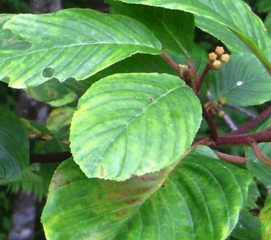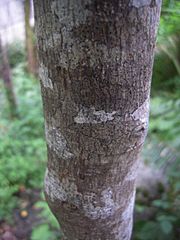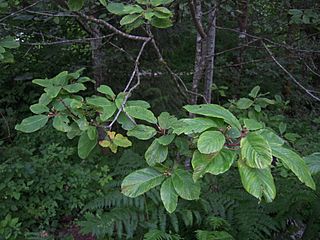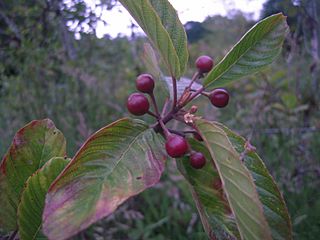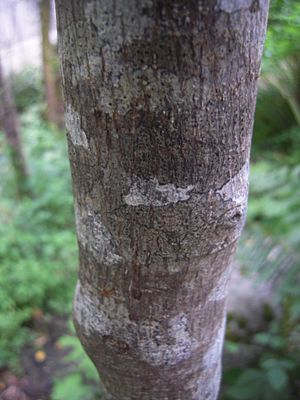Cascara Buckthorn facts for kids
Quick facts for kids Cascara Buckthorn |
|
|---|---|
 |
|
| Scientific classification | |
| Genus: |
Frangula
|
| Species: |
purshiana
|
 |
|
| Natural range | |
| Synonyms | |
|
|
Frangula purshiana, also known as cascara or cascara buckthorn, is a type of plant in the Rhamnaceae family. People also call it cascara sagrada (which means "sacred bark"), bearberry, or in the Chinook Jargon, chittem stick. It grows naturally in western North America. You can find it from southern British Columbia down to central California, and east to northwestern Montana.
For a long time, people used the dried bark of the cascara plant. Native peoples of the Pacific Northwest used it in their traditional medicine. Later, it was used worldwide in regular medicines. It was known for helping with constipation.
What is Cascara?
Cascara is a large shrub or a small tree. It can grow from about 4.5 to 12 meters (15 to 40 feet) tall. Its trunk can be 20 to 50 centimeters (8 to 20 inches) wide. A special thing about cascara is that its buds do not have scales. This is unique for plants in the northwest region.
Bark and Leaves
The bark of the cascara tree is thin. It can be brownish or silver-gray. Often, you will see light spots on it from lichens. The inside of the bark is smooth and yellowish. It turns dark brown when it gets older or is in the sun. Cascara bark tastes very bitter. This taste can stay in your mouth for hours. It can even make your taste buds feel numb.
The leaves are simple and fall off in autumn. They grow in groups near the ends of the branches. Each leaf is oval-shaped, about 5 to 15 cm (2 to 6 inches) long. They are shiny green on top and a lighter green underneath. The edges of the leaves have tiny teeth. In autumn, the leaves turn a bright yellow color.
Flowers and Fruit
Cascara flowers are very small, about 3 to 5 millimeters (1/8 to 1/4 inch) wide. They have five greenish-yellow petals. These petals form a cup shape. The flowers grow in clusters. They bloom for a short time in early to mid-spring.
The fruit is a small, round berry. It is about 6 to 10 millimeters (1/4 to 3/8 inch) wide. At first, the fruit is bright red. Then, it quickly turns a deep purple or black color. Inside, the fruit has a yellow pulp. It also has two or three hard, smooth seeds. These seeds are olive-green or black.
Where Cascara Grows
Cascara grows naturally from northern California up to British Columbia. It also grows east into the Rocky Mountains in Montana. You can often find it near streams in forests. It likes moist areas in valleys and mountains. Cascara is common under larger trees like bigleaf maple.
Sometimes, too much cascara bark has been collected from wild trees. This is because many people wanted to buy it. This has made the number of cascara plants in some areas much smaller.
Cascara and Wildlife
The fruit of the cascara plant is a food source for many animals. Birds, bears, raccoons, and other mammals eat the fruit. When they eat the fruit, they help spread the seeds. The seeds are not digested, so they pass through the animals and can grow into new plants.
Animals That Eat Cascara
Mule deer in Oregon eat cascara leaves. Elk in northern Idaho also browse on the leaves, especially in winter. Olympic black bears, Oregon gray foxes, and raccoons eat cascara leaves too. Ring-tailed cats also eat cascara leaves in areas where they live near the plant.
Shelter and Fire
Cascara plants like shady places. They grow in thick groups, which are great for wildlife. These thick stands offer good places for animals to hide. They also provide warmth and shelter.
If there is a fire, the top part of a cascara tree usually dies. But the plant can often grow back from its roots. After very big fires, new cascara plants can start growing from seeds that come from other areas. This usually happens about two years after the fire.
Is Cascara Safe to Eat?
The fruit and bark of cascara contain a bitter chemical. This chemical makes them not good for humans to eat directly.
For many years, cascara was a main ingredient in some over-the-counter medicines. These medicines were used to help with constipation. However, in 2002, a government agency in the U.S. decided to ban cascara from these medicines. This was because there were concerns about its safety.
Using cascara can sometimes cause problems. These can include losing too much water from your body. It can also affect important chemicals in your body, like potassium. For these reasons, it's important to be careful. Cascara should not be used by pregnant or breastfeeding women, or by children. It can also affect how some other medicines work.
Uses of Cascara
Traditional and Historical Uses
Cascara bark has a long history of use in traditional medicine. Native cultures of the Pacific Northwest Coast used the dried, aged bark. They used it to help with constipation. Later, people from Europe also started using it. They called it "cascara sagrada," which means 'sacred bark' in Spanish. In the traditional Chinook Jargon, it was known as "chittem bark".
When cascara was introduced to formal medicine in the U.S. in 1877, it became very popular. However, this popularity led to too much bark being collected from wild trees. This damaged the natural populations of cascara during the 1900s.
How it was Prepared
The bark was usually collected in the spring or early summer. This is when it is easy to peel from the tree.
After the bark was taken from the tree, it had to be aged for several months. If the bark was used fresh, it could cause vomiting and severe diarrhea. The bark was usually dried in the shade. This helped keep its yellow color. Sometimes, people would bake the bark at a low temperature for a few hours to speed up the drying process.
Other Ways Cascara is Used
The fruit of the cascara plant can be eaten cooked or raw. However, it can also have a laxative effect. The food industry sometimes uses cascara as a flavoring. You might find it in some liquors, soft drinks, ice cream, and baked goods.
Honey made from cascara flowers tastes good, but it can also have a slight laxative effect. The wood from cascara trees is used by local people for fence posts, firewood, and for making small wooden objects. People also plant cascara trees in their gardens. They do this to provide food and shelter for wildlife. It can also help stop soil from washing away. Because of its bitter taste, cascara can even be used to stop nail-biting. You can put it on your fingernails, and the bitter taste will remind you not to bite them.
Images for kids
See also
 In Spanish: Cáscara sagrada para niños
In Spanish: Cáscara sagrada para niños


